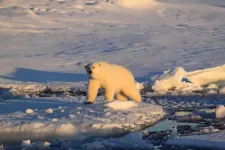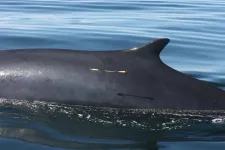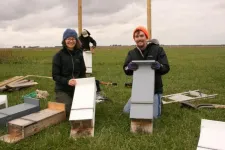(Press-News.org) A randomized trial involving 811 undergraduate students at a U.S. Hispanic-Serving Institution (HIS) university found that students assigned to calculus classes focused on collaborative learning and student engagement had a greater understanding of calculus concepts and improved grades compared to those assigned to classes taught in a traditional lecture style. Laird Kramer and colleagues note that the success of the engagement “treatment” occurred across all racial and ethnic groups, academic majors, and genders. Since calculus is usually a foundation for further study in STEM majors, improving student success is critical for removing barriers to STEM degrees and STEM professions, especially among traditionally underserved students. Kramer et al.’s study at Florida International University, conducted over three semesters, used an engagement model that cultivates “mathematical habits of mind,” including identifying patterns, making connections, and developing and testing hypotheses, mostly in small groups of students with minimal lecturing. Historic pass rates for the introductory calculus class (conducted mostly as lectures) averaged 55%, but the engagement treatment improved this pass rate by 11%, the researchers note. Applying this improvement to all first-time calculus students at the university would translate to 220 additional students passing calculus each year—and 33,000 U.S. students annually if the engagement classes were taught nationwide. The improvements would reduce the number of classes needed each semester and save students nationwide an estimated $23.9 million in tuition, the researchers calculate.
In this week’s Science Podcast, host Sarah Crespi talks with Kramer about his group’s work shaking up the calculus curriculum, and with Science staffers about their own calculus trauma, from fear of spinning shapes to thinking twice about majoring in physics. Beyond anecdotes, research has shown that many students, particularly women and minority students, are deterred from continuing in STEM fields by their experience in calculus courses. The results from Kramer and team show a significant increase in student retention after exposure to a different teaching approach. The podcast discussing the Kramer et al. study will be available at https://www.science.org/podcasts on Thursday, August 31 at 2pm US ET.
END
Student engagement improves calculus class outcomes among undergraduates
2023-08-31
ELSE PRESS RELEASES FROM THIS DATE:
Pedigree approach estimates surprising genetic mutation rate in baleen whales
2023-08-31
A new estimate of the genetic mutation rate in four wild species of baleen whales suggests that these rates are higher than previous estimates, with some interesting implications for calculations of past whale abundance and low cancer rates. For instance, the new mutation rate determined by Marcos Suárez-Menéndez and colleagues reduces estimates of abundance in pre-exploitation whale populations by 86%, which has implications for population-rebuilding goals of whale conservation programs. The mutation rate—the probability ...
Early ancestral bottleneck could've spelled the end for modern humans
2023-08-31
This release has been removed per the request of the submitting PIO. END ...
Developing silicones that are friendlier toward health and the environment
2023-08-31
Polysiloxanes, the scientific name for silicones, possess exceptional properties, and are used in numerous fields ranging from cosmetics to aerospace. They are absolutely everywhere! However, they have a major flaw, as small, cyclic oligosolixanes—toxic for the environment and identified as an endocrine disruptor—form during their synthesis. To correct this drawback, a team of scientists1 led by a CNRS researcher recently developed a new process for synthesising silicones in a cleaner and more environmentally-friendly ...
Study connects greenhouse gas emissions to polar bear population declines, enabling greater protections under Endangered Species Act
2023-08-31
New research from the University of Washington and Polar Bears International in Bozeman, Montana, quantifies the relationship between greenhouse gas emissions and the survival of polar bear populations. The paper, published online Aug. 31 in Science, combines past research and new analysis to provide a quantitative link between greenhouse gas emissions and polar bear survival rates.
A warming Arctic is limiting polar bears’ access to sea ice, which the bears use as a hunting platform. In ice-free summer months the bears must fast. While in a worst-case scenario ...
Exciting the brain could be key to boosting maths learning, says new study
2023-08-31
Exciting a brain region using electrical noise stimulation can help improve mathematical learning in those who struggle with the subject, according to a new study from the Universities of Surrey and Oxford, Loughborough University, and Radboud University in The Netherlands.
During this unique study, researchers investigated the impact of neurostimulation on learning. Despite the growing interest in this non-invasive technique, little is known about the neurophysiological changes induced and the effect it has on learning.
Researchers found that electrical noise ...
How does “MAD” accretion form around a black hole?
2023-08-31
An international scientific team has revealed for the first time the magnetic field transport processes in the accretion flow of a black hole and the formation of a "MAD"—a magnetically arrested disk—in the vicinity of a black hole.
The researchers made the discovery while conducting multi-wavelength observational studies of an outburst event of the black hole X-ray binary MAXI J1820+070, using Insight-HXMT, China's first X-ray astronomical satellite, as well as multiple telescopes.
Key to their discovery was the observation that the radio emission from the black hole jet and the optical emission from the outer ...
Mutation rates in whales are much higher than previously reported
2023-08-31
An international team of marine scientists, led by the University of Groningen in the Netherlands and the Center for Coastal Studies in the USA, has studied the DNA of family groups from four different whale species to estimate their mutation rates. The results revealed much higher mutation rates than previously thought, and which are similar to those of smaller mammals such as humans, apes, and dolphins. Using the newly determined rates, the group found that the number of humpback whales in the North Atlantic before whaling was 86 percent lower than earlier studies suggested. The study is the first proof that this method can be used to estimate mutation rates ...
Peering into nanofluidic mysteries one photon at a time
2023-08-31
Researchers at University of Manchester and the École polytechnique fédérale de Lausanne (EPFL), Switzerland, have revealed an innovative approach to track individual molecule dynamics within nanofluidic structures, illuminating their response to molecules in ways never before possible.
Nanofluidics, the study of fluids confined within ultra-small spaces, offers insights into the behaviour of liquids on a nanometer scale. However, exploring the movement of individual molecules in such confined environments has been challenging due to the limitations of conventional microscopy techniques. This obstacle prevented ...
Study demonstrates adding complex component of milk to infant formula confers long-term cognitive benefits
2023-08-31
LAWRENCE, KANSAS — Breast milk is widely acknowledged as the most beneficial nutrition for infants, but many families face medical or logistical challenges in breastfeeding. In the U.S., just 45% of infants continue to be exclusively breastfed at 3 months of age, according to the Centers for Disease Control.
For decades, researchers have sought to create a viable complement or alternative to breast milk to give children their best start for healthy development. New research out of the University of Kansas has shown how a complex component of milk that can be added to infant ...
Do artificial roosts help bats? Illinois experts say more research needed
2023-08-31
URBANA, Ill. — Artificial roosts for bats come in many forms — bat boxes, condos, bark mimics, clay roosts, and cinder block structures, to name a few — but a new conservation practice and policy article from researchers at the University of Illinois Urbana-Champaign suggests the structures haven’t been studied rigorously enough and may harm bats in some scenarios. The article, published in Conservation Biology, lays out potential dangers and encourages more research on the popular conservation practice.
“The major emphasis among conservation managers using artificial roosts is how to attract ...




